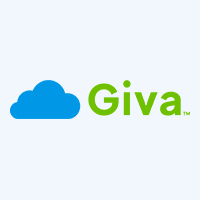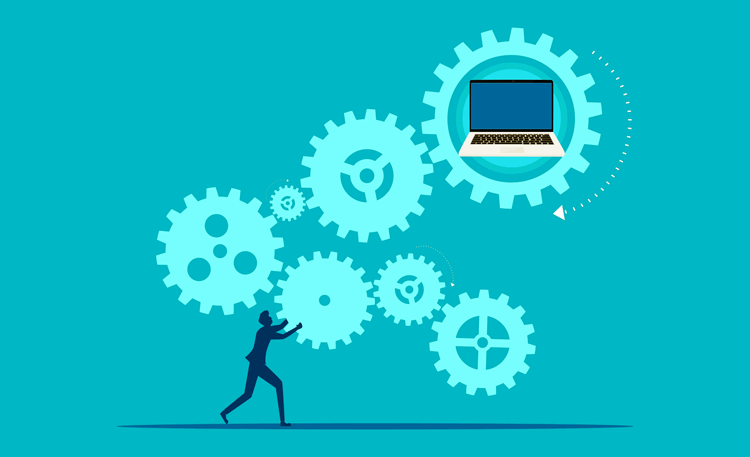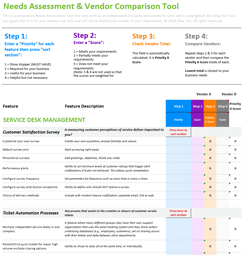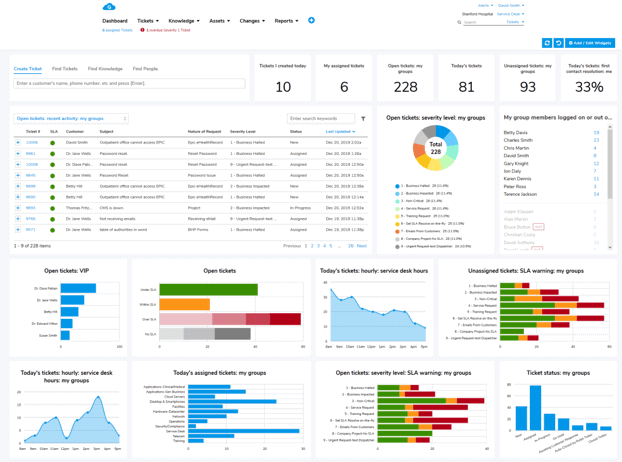Top 10 ITSM Best Practices Plus Action Items for CIOs and IT Leaders
IT Service Management (ITSM) aligns IT operations with what a company or organization needs. ITSM covers the needs of staff, customers, and business leaders, with the aim of ensuring that IT supports, empowers, and improves every aspect of an organization's operations.
There are several different frameworks IT leaders can use to develop ITSM processes that work for their team and organization. There isn't a one-size-fits-all approach, and the same applies to ITSM software.
With ITSM, the goals are to make sure that:
- IT runs smoothly, and if anything goes wrong, it can be fixed quickly
- IT contributes to the overall productivity of the organization
- IT remains an innovation hub, finding new ways to work faster, more efficiently, thereby driving top and bottom-line improvements
Let's look at the best ways that IT leaders can achieve those goals thanks to ITSM. In this article, we look at 10 ITSM best practices that CIOs and IT managers need to know more about.
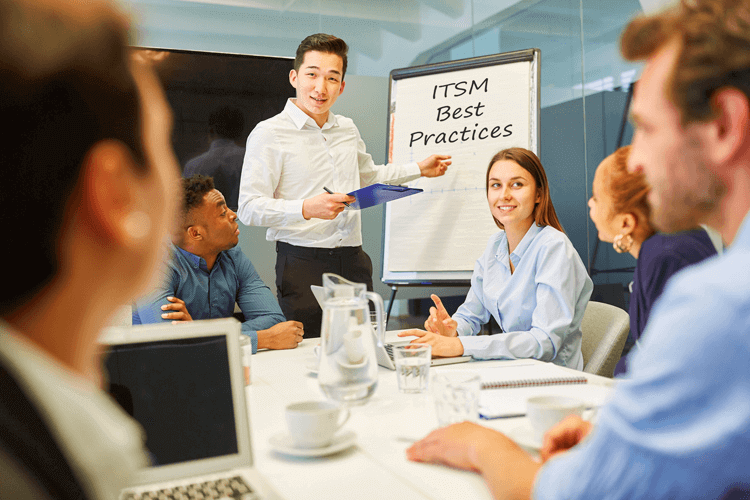
What is ITSM (IT Service Management)?
IT Service Management (ITSM) refers to the strategic approach organizations employ to design, deliver, manage, and enhance the way IT services are used across organizations and teams.
Rather than focusing solely on technology, ITSM emphasizes aligning IT services with the needs of the business. This helps keep IT processes supporting organizational goals and delivering value to customers.
Given the importance of IT in every aspect of our working lives, it's never been more important to keep IT systems, processes, networks, and hardware running smoothly.
Frameworks like ITIL (Information Technology Infrastructure Library) provide structured methodologies for implementing effective ITSM practices.
ITIL™ is a registered trademark of PeopleCert, as the concept was formed in British government departments in the 1980s, simply as a way of making sense and making more effective use of IT systems and processes.
It evolved into a joint venture between the Cabinet Office, the central and most important office within the UK government, and the outsourcing and tech giant, Capita, known as Axelos, which was then sold to PeopleCert in 2021.
ITIL is seen as a way of giving ITSM a framework and certifiable training methodologies for everything from asset management (ITAM) to training for IT leaders, like CIOs. Let's look at the key features of ITIL 4™, the most up-to-date ITIL model that influences and shapes ITSM.
Key Features of ITSM, Particularly ITIL 4
ITIL 4, the latest iteration of the ITIL framework, introduces a more flexible and holistic approach to ITSM. Key features of ITIL 4 include:
-
Service Value System (SVS)
A comprehensive model that integrates various components to facilitate value co-creation through IT services, ITSM, and the alignment of IT around operational needs.
-
Four Dimensions Model
Focuses on the following four areas:
- Organizations and people
- Information and technology
- Partners and suppliers
- Value streams and processes
This combined, balanced approach to service management is designed to make following ITIL principles practical and value-generating.
-
Guiding Principles
Seven principles that promote a culture of collaboration, simplicity, and continuous improvement. The 7 guiding principles are:
- Focus on value
- Start where you are
- Progress iteratively with feedback
- Collaborate and promote visibility
- Think and work holistically
- Keep it simple and practical
- Optimize and automate
-
Integration with Modern Practices
Aligns with Agile, DevOps, and Lean methodologies to support rapid and flexible service delivery.
In most cases, ITIL is the preferred framework for ITSM practices and processes. However, it's worth considering other options, or even borrowing aspects of other frameworks to bring alignment with your operational needs.
4 Other ITSM Frameworks
ITIL isn't the only ITSM framework in town. If that isn't to your liking or doesn't suit how your company operates, then there are alternatives, like the following:
-
COBIT (Control Objectives for Information and Related Technologies)
COBIT focuses on IT governance and provides a framework for aligning IT activities with business goals, providing risk management and regulatory compliance.
-
ISO/IEC 20000
This international standard specifies the requirements for an IT Service Management System (ITSM) and helps organizations achieve certification, demonstrating compliance and adherence to best practices.
-
Lean IT
Inspired by lean manufacturing principles and the Lean startup movement, Lean IT aims to eliminate waste, optimize processes, and improve customer value in IT service delivery.
-
Agile and DevOps
Agile and DevOps methodologies emphasize collaboration, iterative development, and continuous delivery. This enables organizations to respond quickly to changing business needs.
With ITIL, ITSM, and these other four frameworks listed above, AI tools and software are playing an increasingly important role in IT operations. Whether it's AI-first customer service agents or the use of AI Copilots when developers are writing code, AI is here to stay and shape the way IT is used and ITSM services develop.
Now, let's look at why ITSM is mission-critical and the top 10 best practices for ITSM.
Why ITSM is Mission-Critical for Every Organization
ITSM is mission-critical for almost every organization and company for a number of reasons, including but not limited to:
-
Enhanced Efficiency
Streamlining IT processes reduces redundancy and improves service delivery. This helps the entire organization because a more efficient IT service makes work easier for everyone.
-
Cost Optimization
Effective ITSM practices help in identifying and eliminating waste, leading to significant cost savings. Like using AI and self-serve tools to answer customer questions first, before IT tickets go to agents.
-
Improved User Satisfaction
Consistent and reliable IT services enhance the user experience, bringing higher satisfaction rates. ITSM teams have numerous KPIs to achieve, such as First Contact Resolution (FCR), Average Handling Time (AHT), and customer satisfaction scores, such as Net Promoter Score (NPS).
-
Risk Management
Structured change and incident management processes manage the risk of potential disruptions. Keeping downtime to a minimum is essential for operational productivity and to achieve SLA scores of 99.999%. This in most cases is mission-critical and applied across most industries.
-
Strategic Alignment
Ensures that IT services are in sync with business objectives, resulting in better decision-making and value creation. If ITSM isn't aligned with strategic objectives and processes, then it can damage productivity and cost millions in lost revenues, extra costs, and even increase the risk of cyberattacks.
Now, let's look at the top 10 most important ITSM best practices.
10 ITSM Best Practices
-
Establish Service Level Agreements (SLAs)
Setting clear SLAs is critical for clarifying expectations between IT service providers and users. SLAs define the level of service expected, metrics for evaluation, and remedies for service failures.
Regularly reviewing and updating SLAs keeps them aligned with business needs and technological advancements. If the IT team consistently struggles to achieve SLA-based targets and KPIs, then it's worth reviewing resources, whether the IT tools are up to the job, alongside training, and self-serve and AI solutions currently being used.
-
Align Service and Strategy
IT services should be designed and managed in alignment with the organization's strategic objectives. This alignment helps IT investments contribute directly to business goals, enhancing overall performance and competitiveness.
A misalignment can cause service disruption and can impact the IT team's productivity and morale. It can also contribute to other problems, like increasing the risk of cyberattacks.
-
Manage Change Using ITSM Processes
Implementing structured change management processes minimizes the risks associated with IT changes. By assessing potential impacts, obtaining necessary approvals, and communicating effectively, organizations can provide smooth transitions and maintain service continuity.
If you have the right software, you can make change management easier to manage and implement. That's one of the many ways that Giva can help your ITSM team.
-
Have Incident Management Processes
A robust incident management process enables organizations to promptly address and resolve IT incidents, minimizing downtime and restoring normal operations swiftly.
Incident management process includes identification, logging, categorization, prioritization, and resolution of incidents. Again, with the right ITSM software, you can send tickets to the right agents, everything is logged, and support tickets contribute to the internal and customer-facing knowledge base.
-
Automate Recurring Tasks
Automation of repetitive IT tasks, such as password resets or routine system checks, enhances efficiency and reduces the likelihood of human error. Automation also frees up IT personnel to focus on more strategic initiatives.
-
Leverage AI Across Multi-Channel Support Roles
Integrating AI solutions, such as chatbots and virtual assistants, into IT support channels can provide immediate assistance to users, streamline ticket routing, and offer predictive analytics for proactive issue resolution.
Giva's AI-Powered Knowledge Copilot revolutionizes how your teams access and utilize any knowledge, driving efficiency and dramatically improving issue resolution across your organization.
Instantly create knowledge from any files such as PDFs, Word documents, presentations, etc. and bulk upload 100s of files with little effort. Utilize Application Programming Interface (API) to tap internal/external data sources.
AI-powered clarity, tone, grammar rewriting and ticket summary capabilities improve team productivity.
-
Support ITSM Agents With Self-Serve Solutions and Knowledge Management
Developing a comprehensive knowledge base accessed via self-service portals empowers users to resolve common issues independently, reducing the volume of support tickets. Additionally, it serves as a valuable resource for ITSM agents, facilitating quicker and more consistent responses.
This also helps them achieve SLA-based targets more effectively. When people can find the answers they need themselves, the volume of support tickets is lower, and this reduces ITSM workloads and costs.
-
Integrate IT Asset Management (ITAM) into ITSM Processes
Integrating ITAM with ITSM provides a holistic view of the IT environment, enabling better decision-making regarding asset utilization, procurement, and lifecycle management. This integration supports IT services by providing accurate and up-to-date asset information.
-
Allow for a More Flexible Service Value System (SVS)
Adopting a flexible SVS allows organizations to adapt to changing business needs and technological advancements. This adaptability helps IT services continue to deliver value in dynamic environments.
-
Integrate Data Security and Compliance
ITSM processes incorporating data security measures and compliance requirements are vital for protecting sensitive information and adhering to regulatory standards. This integration helps in mitigating risks and maintaining stakeholder trust.
With those in mind, let's look at tasks that IT leaders would benefit from doing to assess the current state of their ITSM operations.
ITSM Action Items for CIOs and IT Leaders
To effectively implement these best practices, organizations should:
-
Assess Current ITSM Maturity
Evaluate existing processes and identify areas for improvement. If you follow ITIL 4 principles, then you can assess your maturity scale more easily and make changes accordingly.
Giva's free ITIL Self-Assessment and Readiness tool can help.
-
Develop a Strategic ITSM Plan
Align ITSM initiatives with business goals and define clear objectives. Ensure that IT and business leadership are aligned and there is a clear roadmap.
-
Invest in Training and Development
Equip IT personnel with the necessary skills and knowledge to adopt new practices and technologies. This should include AI tools and software.
-
Leverage Appropriate Tools
Utilize ITSM tools that support automation, AI integration, and comprehensive IT Asset Management (ITAM).
-
Monitor and Review
Continuously monitor ITSM processes, gather feedback, and make iterative improvements.
And wrapping this up, here are some key takeaways on ITSM best practices, followed by some useful resources.
ITSM Best-Practice Key Takeaways
As we said at the start, IT Service Management (ITSM) aligns IT operations with what a company or organization needs.
Following the best practices in this article, and selecting the best framework (e.g., ITIL 4, Lean, Agile, etc.) are the most effective ways to make sure that IT supports the organization in ways to drive productivity and continuous innovation.
ITSM needs to stick to the following core principles and practices to make that possible:
- Strategic Alignment: Helping IT services support business objectives enhances overall organizational performance.
- Efficiency and Productivity: Automation and structured processes reduce manual workloads and improve service delivery.
- User Empowerment: Self-service portals and knowledge management foster user independence and satisfaction.
- Risk Mitigation: Effective change and incident management processes minimize disruptions and maintain service continuity.
- Compliance and Security: Integrating security measures and compliance requirements into ITSM processes safeguards data and offers regulatory adherence.
Useful ITSM Resources
- Giva's Complete Guide to IT Service Management (ITSM)
- Giva's People and AI-Powered HIPAA-Compliant IT Service Management (ITSM) Software
- Discover Giva's Library of Expert ITIL Information
- Guide to Performing an ITSM Software Requirements Analysis: Free Assessment Tool Included
- Top 15 Benefits of ITSM Plus How-To Tips
Learn more how Giva can help streamline your ITSM operations. Get a demo to see Giva's solutions in action or start your own free 30-day trial today!
